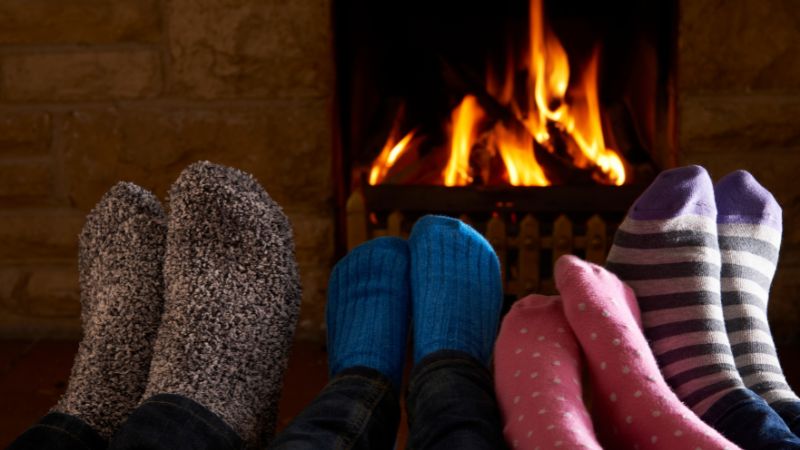Picking the right size for your heating system is a biggie. You don't want a heater that's huffing and puffing to warm up your space, but also, who wants to crack open a window in the dead of winter because it's too toasty inside?
No matter how cosy your tiny home might be, you're going to need some warmth in the winter. So, to nail down the perfect heating setup, it's super important to figure out how much oomph (aka kilowatts of heat) you'll need. Armed with that intel, you can dive into exploring your heating options like a pro.”
Here’s one way on how you can calculate the kW rating needed for your heating source:
Measure Your Space: Multiply the length, width, and height of your tiny house interior in meters to find its volume in cubic meters.
Basic kW Need: In New Zealand, you generally need 1kW for every 14 cubic meters of well-insulated, double-glazed space to stay warm. Divide your space's volume by 14 to find this base requirement.
Adjustments: Poor Insulation: Increase your base kW need by 20% if your insulation isn't up to New Zealand standards.
Single-Glazed Windows: Add 0.5kW for each window.
Total kW: Add any window adjustments to your base need. If you have poor insulation, apply this increase before adding for windows.
Example: A tiny house of 75 cubic meters with double-glazed windows and good insulation needs a heating source of at least 5.35kW. This is a basic guideline only; for precise needs, consult a heating specialist.
Picking the perfect heater for your tiny house comes down to a couple of important things, and we're here to guide you through choosing the right one. First up, you need to figure out if your tiny house will be connected to the grid or living off-grid. Being on the grid opens up a wider range of heating possibilities, including ever-so-handy electric heaters and heat pumps. However, if you're setting up off the grid, your choices narrow down to the rustic charm of wood burning or the traditional route of fossil fuels, unless you are installing a large-sized solar system.
Now let’s look at the main heating options.
Electric Powered Heating Sources
Convection Heaters:
How They Work: Heat air that circulates through the heater, warming up the room by natural air movement or with the aid of a fan.
Pros: Provide even, whole-room heating; relatively energy-efficient for continuous use.
Cons: Can be slow to heat a room; may not be the most efficient choice for off-grid living due to power requirements.
Dampness: Convection heaters can help reduce dampness by warming the air and promoting evaporation of moisture.
Human Health: Generally safe, convection heaters can occasionally circulate dust and other allergens within a room, which may be a concern for those with respiratory issues.
Radiant (Infrared) Heaters:
How They Work: Emit infrared light that directly heats objects and people in its path without heating the air.
Pros: Offers immediate warmth; efficient for direct heating in a small space or specific area.
Cons: Does not heat the air, so the warmth might be localized; might not be ideal for whole-room heating in an off-grid tiny house.
Dampness: Radiant heaters have a limited effect on dampness since they heat objects directly rather than the air, which does little to reduce ambient moisture.
Human Health: Radiant heaters do not usually pose health risks as they heat objects directly without affecting the air quality; however, prolonged direct exposure should be avoided to prevent skin burns.
Oil-Filled Radiators:
How They Work: Electric element heats the oil inside, and the heat is then radiated into the room.
Pros: Provides steady and sustained heat; energy-efficient for prolonged use as the oil retains heat well.
Cons: Heavy and not easily portable; slow to heat up, making them less suitable for quick heating needs.
Dampness: Oil-filled radiators indirectly help reduce room dampness by maintaining a steady temperature that supports a drier environment.
Human Health: Oil-filled radiators are considered safe as they do not emit fumes or burn oxygen; however, their surfaces can become extremely hot and pose burn risks if touched.
Panel Heaters:
How They Work: Use electricity to warm up a slim panel, radiating heat into the room through convection.
Pros: Sleek and unobtrusive design; can be wall-mounted to save space, making them ideal for tiny houses.
Cons: Might not be powerful enough for the entire space; some models may have higher electricity demands.
Dampness: Panel heaters can assist in reducing dampness by increasing the room temperature, which helps to evaporate moisture.
Human Health: Panel heaters are low risk in terms of health concerns but like other electric heaters, they can contribute to dry air which might irritate skin and respiratory passages.
Ceramic Heaters:
How They Work: Use a ceramic element to heat up air, distributing it through the room with a fan.
Pros: Quick to warm up a space; often portable and suitable for targeting specific areas.
Cons: Fan can be noisy; running the fan consumes additional power, which might be a concern off-grid.
Dampness: Ceramic heaters can help decrease dampness by warming the air and surfaces, allowing moisture to evaporate more quickly.
Human Health: Ceramic heaters are safe for indoor use as they do not burn oxygen or emit fumes; however, they can produce a small amount of ozone and should be used with ventilation to minimize any potential irritation.
Fan Heaters:
How They Work: Blow air over a hot element to warm up a room quickly.
Pros: Provides rapid heat; compact and portable.
Cons: Noisy operation due to the fan; not the most energy-efficient, especially in off-grid settings.
Dampness: Fan heaters can be effective in reducing dampness by circulating warm air, which speeds up the evaporation of moisture.
Human Health: Fan heaters may stir up household dust and allergens, potentially aggravating asthma or allergies.
Halogen Heaters:
How They Work: Use halogen bulbs to emit infrared light, heating objects directly in front of them.
Pros: Instant heat; ideal for spot heating and saving energy in targeted areas.
Cons: Light can be intrusive; heating is very localized, not suited for whole-room warmth.
Dampness: Halogen heaters do not significantly improve dampness, as their heat is emitted via radiation that heats objects rather than the air.
Human Health: Halogen heaters pose a burn hazard due to their exposed elements and can also be a fire risk if they tip over or come into contact with flammable materials.
Heat Pumps:
How They Work: Heat pumps work by transferring heat from the outside air or ground into a building during winter for heating, and reversing the process during summer to expel heat from the building to cool it, operating similarly to a refrigerator but on a larger scale.
Pros: Extremely efficient, offering significant energy savings over time; provides both heating and cooling.
Cons: High initial cost and complex installation; may require a consistent power source, challenging for off-grid living.
Dampness: Heat pumps typically do not have a direct impact on reducing dampness unless they are equipped with a dehumidifying feature.
Human Health: Heat pumps are generally considered very safe and health-friendly as they do not create combustion gases; however, poor installation or maintenance can lead to issues like mold growth in ductwork.
Wood Heating Sources
Wood Stoves:
How They Work: Burn wood to produce heat, with the heat distributed by natural convection or a fan-assisted system.
Pros: Can be highly efficient and cost-effective, especially if you have access to cheap or free firewood. Provides a cozy, aesthetic appeal.
Cons: Requires storage space for wood, which might be challenging in a tiny house. Needs regular cleaning and maintenance. Can pose a fire hazard if not installed or used properly.
Dampness: Wood stoves can help reduce dampness by significantly heating the air and reducing relative humidity through combustion.
Human Health: Wood stoves can significantly impact indoor and outdoor air quality by emitting particulate matter and carbon monoxide, posing serious health risks without adequate ventilation and regular maintenance.
Pellet Stoves
How They Work: Burn compressed wood or biomass pellets. They're often automated with a built-in hopper to feed pellets into the fire and an electric fan to distribute the heat.
Pros: More efficient and cleaner burning than traditional wood stoves. Pellet stoves can be thermostatically controlled, providing consistent heat.
Cons: Dependence on electricity to operate fans and feeders makes them less suitable for off-grid unless solar power or a generator is used. Requires purchasing and storing pellets.
Dampness: Pellet stoves can decrease dampness by producing intense heat that dries out the air and reduces moisture content.
Human Health: Pellet stoves are cleaner than traditional wood stoves but can still emit fine particulate matter and require proper venting to avoid air quality deterioration inside the home.
Fossil fuel heat sources
Gas Fireplaces (Propane/Natural Gas)
How They Work: Use propane or natural gas as fuel, igniting flames that radiate heat into the room. Can be vented or vent-free.
Pros: Clean burning and convenient, with no need for wood storage. Instant on/off capabilities and easy heat control.
Cons: Requires a gas supply, which may not be available or practical in remote or off-grid tiny houses. Vent-free models can add moisture and combustion gases to indoor air, which is not ideal for small, enclosed spaces, and can affect your health.
Dampness: Gas fireplaces help lower dampness by heating the air and thus reducing the relative humidity.
Human Health: If not properly vented, gas fireplaces can emit nitrogen dioxide and carbon monoxide, which are harmful to human health.
Diesel Heaters
How They Work: Diesel heaters use diesel fuel to generate heat. They draw in cold air from outside, heat it using a diesel-fueled flame, and then push the warm air into the space.
Pros: Diesel heaters are ideal for off-grid living, offering efficient, cost-effective heating and reliable operation in extreme conditions.
Cons: You need to store diesel fuel, which can require additional space and safety precautions. They can still emit fumes and require proper ventilation to ensure safety.
Dampness: Diesel heaters are effective at reducing dampness because they heat the air rapidly and maintain a dry environment, which helps prevent condensation and mold growth.
Human Health: While they are generally safe, improper use or ventilation can lead to health hazards from fumes or carbon monoxide.
Ethanol Burners
How They Work: Burn liquid ethanol or bioethanol fuel, producing heat and a real flame without needing a chimney or flue.
Pros: Easy to install and use, with no need for a traditional chimney. Produces no smoke, making it suitable for indoor use without extensive ventilation.
Cons: Heat output is generally lower compared to wood or pellet stoves, making them less effective as a primary heat source in colder climates. The cost of ethanol fuel can add up over time.
Dampness: Ethanol burners may slightly improve dampness by adding heat to the room, although their effect on overall humidity can be minimal.
Human Health: Produces small amounts of carbon dioxide and water vapor, improper use of ethanol burners without sufficient ventilation can deplete room oxygen and increase risks of carbon monoxide poisoning.
Whether you're aiming for off-grid charm or grid-connected efficiency, there's a heater out there to suit your lifestyle. Each option has its own pros and cons to consider. Whatever your preference, with careful consideration of factors like cost, efficiency, safety, and installation requirements, you can ensure that your tiny home stays warm and snug through all seasons.


